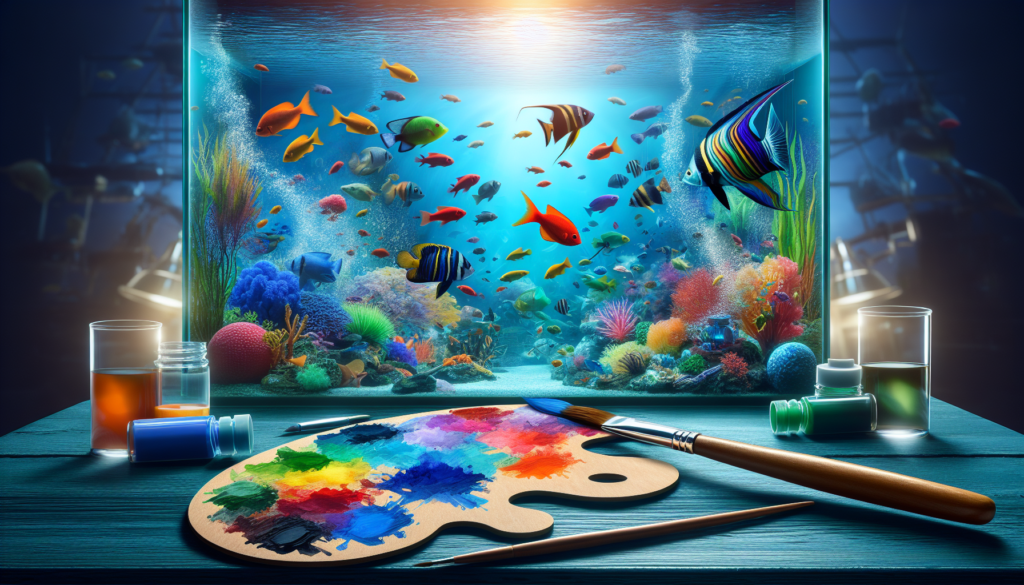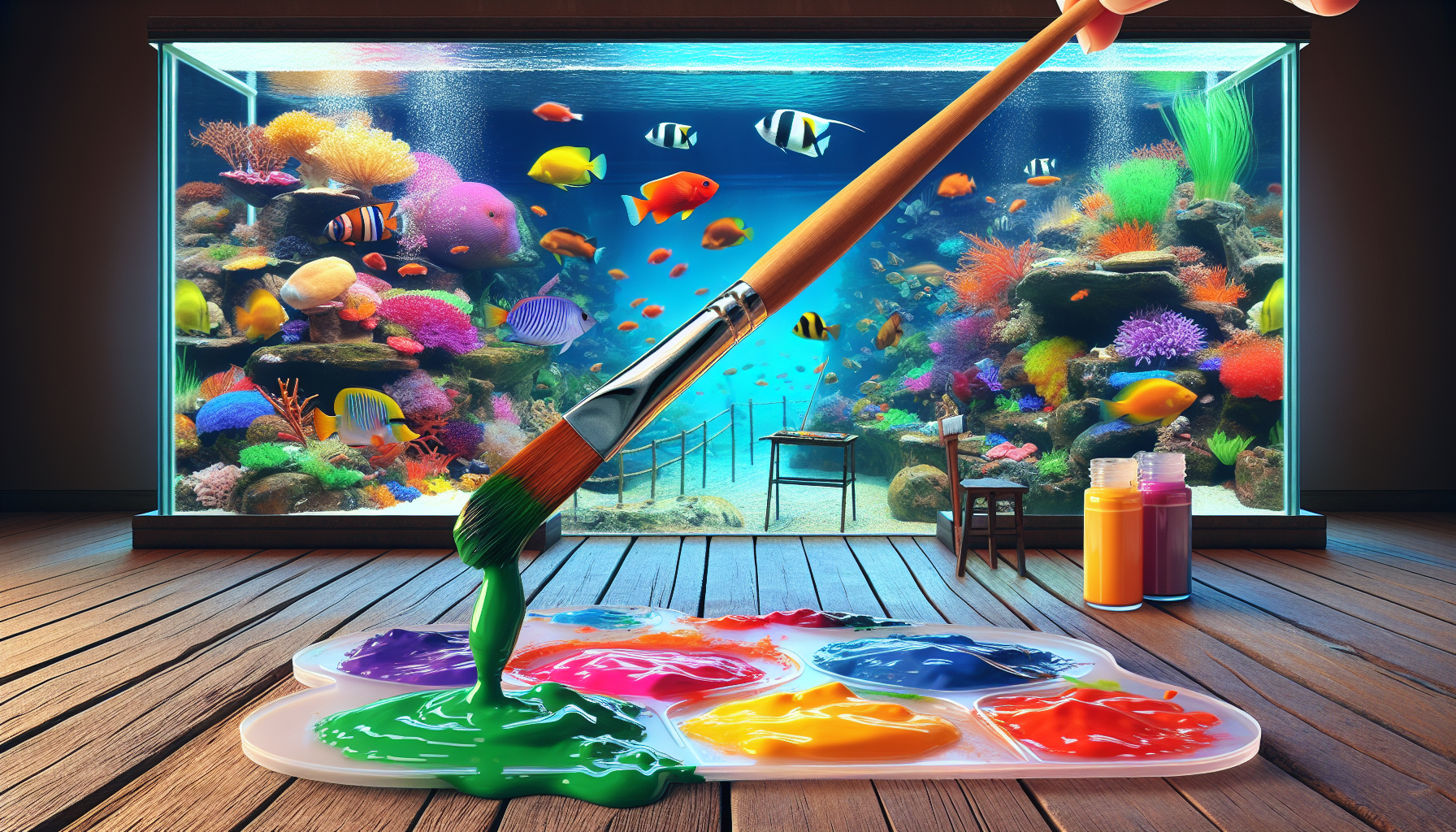In the realm of aquarium aesthetics and decor, you might have pondered over the suitability of acrylic paint. The article, “Is Acrylic Paint Aquarium Safe,” sheds light on this very topic, demystifying the potential risks and benefits associated with the use of acrylic paint inside your aquatic habitat. It explores the chemical compositions of acrylic paint, their potential impact on water quality, and ultimately, their effect on your aquarium’s residents. So, if you’re keen to add a personal touch to your aquarium, reading this article is the first step towards ensuring you do it adequately and safely.

What is Acrylic Paint?
Acrylic paint is one of the most commonly used art materials. Its versatility and ease-of-use make it a favorite among beginners and professionals alike. Acrylic paint is a type of pigment combined with a binder that can be dissolved in water. The binder gives the paint its unique properties, such as how it dries and adheres to surfaces. When the water in acrylic paint evaporates, it leaves behind the paint’s color on the painting surface.
Composition of Acrylic Paint
The primary components of acrylic paint are pigment, binder, and water. Various auxiliary products can be added to regulate its consistency, durability, drying time, and more. The binder in acrylic paint is typically an acrylic polymer emulsion, responsible for the paint’s adhesion and durability features. Acrylic paint is water-soluble but becomes water-resistant when dry.
Common Uses of Acrylic Paint
Acrylic paint is widely used in artistic applications, such as painting on canvas and other surfaces. Due to its durability and resistance to water when dry, it is also used in commercial applications like outdoor signage, murals, and furniture painting. Acrylic paint can be used on most surfaces, including wood, canvas, metal, glass, and more.
Acrylic Paint and Aquarium Decorations
For the creative hobbyist, acrylic paint can serve as a medium to personalize aquarium decorations. Acrylic paint can be used to add vibrant colors and unique designs to aquarium decor. However, pet owners must ensure the safety of their aquatic animals when using acrylic paint in aquariums.
Potential Risks of Acrylic Paint in Aquariums
While acrylic paint may seem like the perfect solution for revamping your aquarium decor, it’s essential to consider potential risks.
Leaching of Chemicals
One potential risk is the leaching of chemicals. While the acrylic polymer emulsion in the paint is generally considered safe, some acrylic paints may contain harmful substances that could be harmful to aquatic life once they start to deteriorate or if they’re not adequately sealed.
Effects on Water Quality
Besides the potential release of harmful substances, acrylic paint could also impact the quality of water in the aquarium. Introduction of foreign materials, like paint, may disrupt the tank’s delicate pH balance, affecting the water’s hardness and potentially leading to harmful conditions for your aquatic inhabitants.
Impact on Aquatic Life
The potential issues raised by the use of acrylic paint in aquariums can directly impact the aquatic life in your tank. Exposure to harmful chemicals or drastic changes in water conditions can lead to stress, illness, or even death among your fish or other aquatic creatures.
Factors Affecting the Safety of Acrylic Paint in Aquariums
Though there are risks, the safety of acrylic paint in aquariums largely depends on a few key factors.
Quality of Acrylic Paint
The quality of the acrylic paint plays a crucial role in determining its safety. High-quality paints should not contain harmful or toxic substances, ensuring the safety of your aquarium inhabitants. Make it a point to research thoroughly about the constituents of the chosen paint.
Curing and Drying Time
After painting your aquarium decoration, allowing the paint to cure and dry completely is essential. This process can minimize the risk of chemicals or paint particles affecting your aquarium’s water quality.
Application Techniques
Proper application of the acrylic paint is another important factor. Applying thin layers of paint and allowing each to dry fully before applying the next can increase the stability and lifespan of the paint job, reducing the likelihood of chipping or peeling.
Testing Acrylic Paint for Aquarium Safety
Proactively testing the safety of acrylic paint for your aquarium can mitigate many potential risks.
Researching Paint Brands
Before buying any acrylic paint, research which brands are known to be safe for aquarium use. Reviews from other aquarists are a valuable resource in this regard.
Using Non-Toxic or Fish-Safe Paints
Ideally, you should choose non-toxic or “fish-safe” paints. These products are designed with aquatic safety in mind and will minimize the risk to your aquarium’s inhabitants.
Performing a Compatibility Test
Finally, conducting a compatibility test is a good idea. Paint a small, non-essential item and keep it in a container of water for a week or two. Then, test the water parameters to see if they’re within the safe range.

Alternatives to Using Acrylic Paint in Aquariums
If the potential risks of using acrylic paint worry you, there are alternatives available.
Natural Decorations
Natural decorations like rocks, driftwood, and aquatic plants can lend an organic look to your aquarium and provide environmental enrichment for your aquatic animals, all without introducing the risks of paint.
Unpainted Decorations
Several types of aquarium-safe decor come unpainted and offer a safer alternative. Artificial plants, ceramic decorations, and resin items come in a variety of shapes, sizes, and colors, giving you a broad spectrum of non-toxic decoration options.
Safe Adhesive Options
Some adhesives are safe for aquariums and can be used to adhere crushed rocks, sand, or other natural materials to your decorations for added color and texture.
Precautions and Recommendations
To keep your aquarium safe when using acrylic paint, follow these precautions and recommendations.
Consulting with Aquarium Experts
Before starting any painting projects, it can be useful to consult with an aquarium expert or experienced aquarist. They can provide guidance and potentially recommend safe paint brands or application techniques.
Properly Preparing Decorations
Before painting, thoroughly clean any aquarium decorations to remove any grime, algae, or biofilm that could prevent the paint from adhering properly.
Monitoring Water Parameters
Finally, after adding painted items to your aquarium, monitor your water parameters closely for a few weeks. Any significant changes in pH, hardness, or other water conditions could signal that the paint is affecting the water quality.
Conclusion
While acrylic paint can bring a pop of color and personality to your aquarium decorations, it’s essential to understand the potential risks and precautions. Although some acrylic paints can be safely used in aquariums, always research your chosen paint’s composition, study its impacts and consider safer alternatives for your aquarium. With proper caution, you can create a beautiful and safe environment for your aquatic pets.



